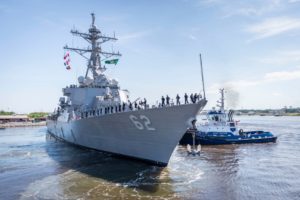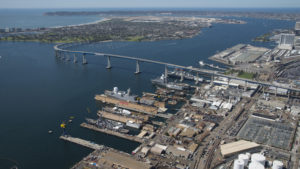The Navy is both looking at plans to get wartime surge capability for protracted conflicts but at the same time is worried about limited repair capabilities.
Program Executive Officer for ships Rear Adm. Tom Anderson said Navy acquisition chief James Geurts put a group together two years ago to have a discussion about wartime planning involving industrial base capabilities.

“How prepared are we to go to the fight and what would we do and how do we get better prepared? So we put some energy into developing what I’ll say is kind of the playbook, which is – if we had to pull the trigger on in wartime or leading up to wartime, what kind of things would we go after,” Anderson said during a Navy League webinar on Aug. 25.
Anderson referred to what is called the Wartime Acquisition Scalable Plan (WASP). A 2019 Navy CHIPS magazine article said the WASP focuses on the industry-base acquisition process as well as the concept of end-to-end processes in how ships are repaired in-theater to get back into a protracted fight as soon as possible.
The article noted Geurts stood up WASP in 2019 “to identify and address acquisition vulnerabilities and readiness in transitioning from peacetime to a wartime scenario.”
Anderson noted the team started planning on what kind of new authorities the Navy would ask from Congress allowing them to move faster in construction and repairs.
“For the new construction guys, how would we rapidly get the ships that were close to delivery out of the yards. How would we accelerate the ships that were in the yards and then what could we expect for kind of throughput going forward,” he said.
They also looked at what repair capability could the Navy leverage to do some new construction work.
“So that calculus exists, that’s been a work in progress for about the last two years. But I would tell you it goes beyond what we’re currently doing. It really is a more national look at what is the national capacity and how would we energize it.”
However, at the same event, Rear Adm. Eric Ver Hage, director of the Navy Regional Maintenance Center and Naval Sea Systems Command Surface Ship Maintenance and Modernization, bluntly noted, “we don’t have enough capacity for peacetime,” let alone adding wartime work.
“Think about how long it took [USS Fitzgerald (DDG-62) and [USS John S. McCain (DDG-56)] to get back in operations. We’ll see what we do with the Bonhomme Richard, but that’ll be a massive effort to repair her if that’s what the decision goes – I’m talking years at most likely.”
The Fitzgerald and McCain both had lengthy repair periods following separate deadly collisions at sea with commercial vessels in the Western Pacific in 2017.
A fire on the USS Bonhomme Richard (LHD-6) raged for four days in July, causing extensive damage. An investigation is currently underway. Following an assessment, the Navy will decide whether to repair the ship or let it go (Defense Daily, July 17).
Ver Hage argued more public, private, and public-private partnership investments are needed in ship repair facilities.
He named the CARES Act passed by Congress as well as various Defense Production Act actions as good examples of the public investment amid the COVID-19 pandemic.
Likewise, he noted the Carlyle Group and Stellex Capital Management jointly acquired the ship repair companies Vigor Industrial and MHI Holdings in 2019. In buying the companies, the two companies formed the new firm Titan Acquisition Holdings.
In February, Titan agreed to acquire a majority interest in Huntignton Ingalls Industries [HII] San Diego-based ship repair facilities, one of the largest repair sites in the U.S. (Defense Daily, Feb. 12).

Ver Hage said he sees those acquisitions and investments as a good sign. “If they’re putting money into it, they see a future in it.”
In February, Titan Chairman Tom Robaut explained they aim to create a company of scale capable of coast-to-coast services.
Speaking during a press call on Thursday, Geurts explained the wartime acquisition team has been very active and has since been broken into cells looking at specific sectors including ship repair, aviation, and electronic combat systems.
“What the team has been doing is really thinking through where are there friction points. Where is there fragility? Where are there plans and authorities that we need to have in mind and in place early and then…what would be our execution plan as we went forward?”
He said that includes detailed specifics about the industrial base and capability “and then some of that is thinking about capability that does not exist.”
For example, Geurts noted they have surveyed where there is drydock capacity that the Navy has not traditionally used, but could in a wartime scenario.
“NAVSEA has offered to inspect and evaluate drydock capacity in advance – so all those are things we’re looking at.”
Geurts reiterated that “a lot of the work we’ve done there of standing up those supply teams and teams to understand where we would have to scale rapidly – that helped us pivot very quickly in COVID.”
The teams’ understanding of friction points, bottlenecks and fragility in the industrial base helped the Navy pivot to pay special attention and “proactively address issues there.”
Geurts said the service continues to refine these plans.
“We’ve been developing and understand where there’s untapped potential and then use that thinking as we look strategically with programs like the Defense Production Act and some of the other things where we want to build resilience and capacity back into the system so we can scale more rapidly.”